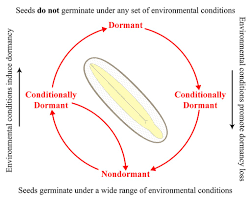SEED DORMANCY- TYPES & ADVANTAGES
INTRODUCTION
- Seed dormancy may be defined as a block or resting phase to the completion of germination of an intact viable seed even under the favorable conditions required for germination.
- This block (Dormancy mechanism) to germination may vary across species through adaptation to the prevailing environment, so that germination occurs when conditions for growing a new plant generation are likely to be suitable. Such mechanism or block depends on diversity of climates and habitats in which they operate.
- According to Baskin & Baskin (2004), a dormant seed does not have the capacity to germinate in a specified period of time under any combination of normal physical environmental factors that are otherwise favorable for its germination, i.e. after the seed becomes nondormant.
- Dormancy can only be measured by the absence of germination.
Read….SEED MEANING- FUNCTION & IMPORTANCE
CLASSIFICATION OF DORMANCY
There are three types of dormancy based on their mode of action-
- Physical,
- Physiological and
- Morphological Dormancy
Dormancy may be caused by conditions outside the embryo or by conditions within the embryo itself.
When it is caused by conditions outside the embryo, it is grouped into following categories-
Physical Dormancy
- Dormancy caused by an impermeable seed coat is called physical dormancy.
- It is caused by water‐impermeable layers of palisade cells in the seed or fruit coat that control water movement. Such layer(s) prevents the seed from taking up water or gases. Consequently, seeds fail to germinate until dormancy is broken.
- Physical dormancy has been noticed in the seeds of plants across 16 angiosperm families. However, Physical dormancy has not been recorded in any gymnosperms.
- Some important angiosperm families wherein, it has been identified are as follows:
- Anacardiaceae
- Asteraceae
- Cannaceae(monocot)
- Cistaceae
- Convolvulaceae
- Cucurbitaceae
- Malvaceae
Mechanical Dormancy
When seed coat is too hard, it does not allow embryo to expand during germination.
Chemical Dormancy
It is induced by the growth regulators present around the coverings of an embryo.
When it is caused by conditions within the embryo itself, May grouped into following categories-
Physiological dormancy
- Physiological dormancy prevents embryo growth and seed germination until chemical changes occur.
- It is the most abundant form and is found in seeds of gymnosperms and all major angiosperm clades.
- It is also the most prevalent dormancy form in temperate seed banks and the most abundant dormancy class ‘in the field’.
- Some seed need a period of drying before they will germinate; the seeds are released but need to have lower moisture content before germination can begin. If the seeds remain moist after dispersal, germination can be delayed for many months or even years.
- Many herbaceous plants from temperate climate zones have physiological dormancy that disappears with drying of the seeds.

- Some seeds are light sensitive and need a period of darkness or light to germinate, called Photo dormancy. Species with thin seed coats, light may be able to penetrate into the dormant embryo. The presence of light or the absence of light may trigger the germination process, inhibiting germination in some seeds buried too deeply or in others not buried in the soil.
- Similarly, some seeds are sensitive to heat or cold (Thermo dormancy) such as, cocklebur and amaranth germinate only at high temperatures (30C).
Morphological dormancy
- In this case, the embryo is underdeveloped or undifferentiated.
- Some seeds have fully differentiated embryos that need to grow more before seed germination, or the embryos are not differentiated into different tissues at the time of fruit ripening.
- Combination of immature embryo with inhibitors leads to morphological dormancy.
Importance of dormancy
- Storage life of seed is prolonged.
- Seed can pass through adverse situation.
- Prevents the in situ germination.
- It follows the storage of seeds for later use by animals and man.
- It helps in the dispersal of the seeds through the unfavorable environment.
- Dormancy induced by the inhibitors present in the seed coats is highly useful to desert plants.
- Dormancy helps seeds to remain alive in the soil for several years and provides a continuous source of new plants.
Disadvantages
- Long periods of time needed to overcome dormancy (for uniform germination)
- Contributes to longevity of weed seed.
- While raising a crop it is very difficult to maintain the population in the field with dormant seed lot.
Read more….
SEED GERMINATION-PROCESS & FACTORS OF GERMINATION
Nice content bhaiya